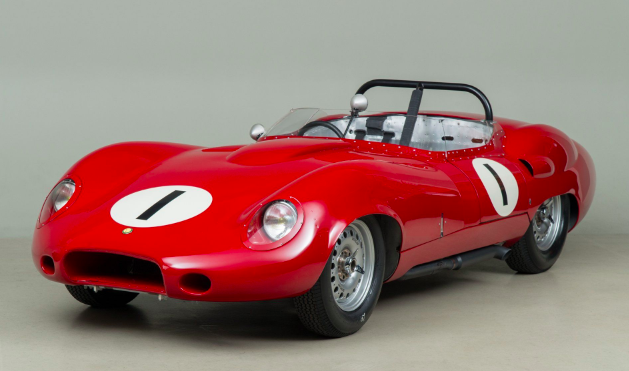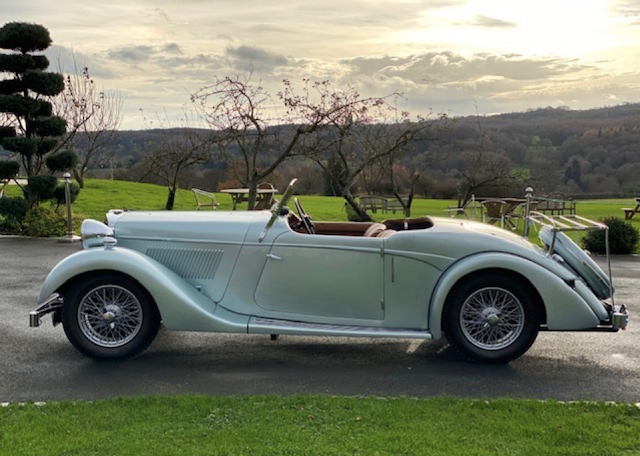Young vintage race fans might have been mystified by this blue car at the Monterey Historic Races last year. The sleek contours seemed to have a hint of Old Jaguar, and the number plate was a sign of Old England. The enclosed wheels could have reminded older fans of Lotus* road racers from the late Fifties. But maybe it would take a detail-obsessed design wonk to put those clues together. The car is a '59 Lister Jaguar with body designed by Frank Costin*, who also designed the similarly sleek Lotus racers of the era. In the early Fifties, Brian Lister, son of industrialist George Lister, began building and racing cars inspired by Cooper, and first noticed Archie Scott Brown when the young racer nearly beat Lister while driving a less powerful MG TD. Lister decided to concentrate on building cars, with Scott Brown as his driver. The chassis designs were similar to the early front-engined Coopers, with tubular ladder frames, De Dion rear suspension, and inboard rear drum brakes. MG and Bristol engines were tried, and despite the conventional design and having only one fully functional hand, Scott Brown won the two-liter class at Silverstone in 1954. Brian Lister tried a more aerodynamic design in 1955; he's pictured on the left, with Scott Brown at the wheel...
This car soon morphed into the legendary Knobbly, nicknamed for its somewhat lumpy curves. After Jaguar withdrew its factory-supported D-Types from racing in 1957, Listers powered with D-Type engines began to take their place. Disc brakes, inboard at the rear, replaced drums, but the ladder frame and De Dion rear remained. Scott-Brown won the British Empire Trophy, and 11 of the 14 races he entered that year. For 1958, the Lister team entered international endurance races, but Scott Brown was killed in May at Spa in Belgium...
Scott Brown's death could well have caused the despairing Lister team to abandon racing altogether, but there were customer cars to be delivered, and late in 1958 Lister tested a lower, sleeker alloy body shell designed by Frank Costin, the ex-De Havilland aIrcraft designer who penned the Lotus 11, 15 and 17. The new design featured enclosed wheels like those Lotus sports racers, a lower profile than the Knobbly, and less frontal area. Initially Lister kept the same chassis frame as the Knobbly, with De Dion rear end and inboard rear discs to keep up with the power, which was supplied by Jaguar in the example below...
As on Costin's design for the Lotus Eleven, the doors were hinged at the sill, and opened downward. Impractical for daily transportation, but simple and elegant, like the whole car.
Just before building the Jaguar-powered Costin designs, Lister offered the same chassis and body design with Chevrolet power. At a minimum, a baker's dozen Lister Costins were built. There was the Chevy-powered prototype below, 3 "production" versions with Jaguar engines, 8 production cars with Chevy power, and one with a Maserati V8. Other accounts list as many as 17 cars built with Costin's body design...
The total should include the aerodynamic, Jaguar-powered coupe below. Late in 1959, Lister developed a lighter, multi-tubular space frame chassis, but cost issues prevented them from racing it or offering it to customers. Lister disbanded its racing team after that year, and the space frame chassis sat idle while mid-engined cars made by Cooper*, Lotus and eventually Ferrari showed the way to minimize frontal area and centralize mass. Peter Sargent and Peter Lumsden thought the front-engined Lister still had potential, and in 1963 they commissioned a new coupe body for a '59 Lister space frame chassis to compete at Le Mans that year. Only one was built, with 3.8 liter E-Type engine making 306 hp. The concave roof section aimed at minimizing frontal area. Clutch failure meant that the coupe dropped out during the 24 hour race. It still exists, though; a reminder that Costin's designs for Lotus and then Lister may have represented the pared-down, elegant peak form for front-engined racers.
Later in 1963, Brian Lister began preparing 3 Sunbeam Tiger coupes for the '64 Le Mans. Under different ownership, Lister Cars created around 90 specially-tuned versions of the Jaguar XJS in the late Eighties, and later on, replicas of the original Knobbly. But the Lister cars that etched the name into the record books were all built in the Fifties...
*Footnote:
Frank Costin's designs for Lotus are profiled in "Lotus Eleven: Breakaway Moment for Lotus Cars", posted here on March 20, 2023, and in "Forgotten Classics: Lotus, Between Seven and Eleven" (March 10, 2023). We reviewed the history of Britain's HWM sports racers, also powered by Jaguar and Chevy engines, in "Forgotten Classic: HWM---Racing Into Obscurity on Alta, Jaguar and Chevy Power", posted on November 23, 2020. The history of Cooper Cars, "Cooper Cars Followed a Winding Road to the Major Leagues", was posted here on February 11, 2022.
Photo Credits:
Top: the author
2nd: pinterest.com
3rd: rmsothebys.com
4th & 5th: 1cars.org
6th: motorious.com
7th: goodwood.com
Bottom: pinterest.com












































